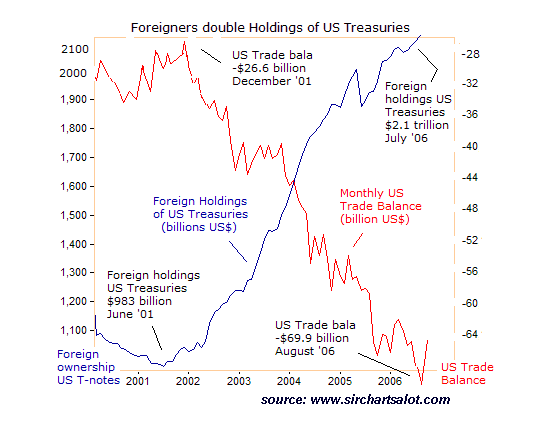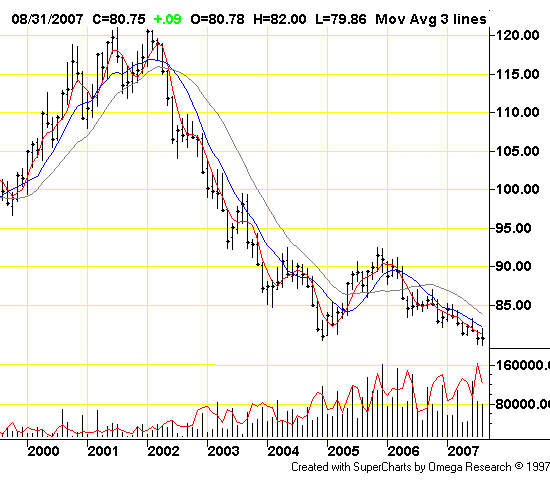

|
| weblog/wEssays archives | home | |
|
Will Foreign Owners Dump U.S. Stocks and Bonds? (September 11, 2007) On this, the somber anniversary of 9/11, it is perhaps appropriate to ponder the global nature of the U.S. economy: In particular, the non-U.S. ownership of U.S. stocks and bonds, and what could cause foreign central banks and investors to sell some or all of those assets. Longtime correspondent and fellow blogger Fred Roper submitted an intriguing article from the U.K., Is China quietly dumping US Treasuries? The issue is being sharpened by the drop in the dollar, described here on Sept. 8: The Big One Just Hit. In a weirdly self-absorbed manner, the mainstream media and its countless swarm of analysts are focusing almost exclusively on domestic concerns and Fed rate cuts, as if foreign investors didn't have a $12 trillion stake in the dollar. (I have seen that amount in print but found no reliable source for such a total. But based on my admittedly limited review of the Bureau of Economic Statistics monumental report Foreign Direct Investment in the U.S.: Country and Industry Detail for Capital Inflows 1994-2006 this does not seem an unreasonable guesstimate.) This site has many non-U.S. readers. I now ask my U.S. readers to put themselves in the shoes of a non-U.S. portfolio manager who is trying to preserve the capital he/she has been entrusted with. If you reckoned the dollar, having broken a key support level and vulnerable to cuts in U.S. interest rates, might plummet 10% or even 20%, you would be duty-bound to wonder if the best capital-preservation strategy might be to sell all your U.S.-based assets now before they lose 20% of their value. I know I would. To gamble that the dollar would appreciate in such a precarious time would be a very risky bet. So how much U.S. stock and bonds do non-U.S. entities own? Let's start with Treasuries, and a chart from Sir Charts Alot: 
For some background on the high foreign ownership of bonds, let's turn to Bloomberg: Foreign U.S. Notes Rise to 80 Percent; Treasuries Irresistible: For the moment, at least, financing the U.S. budget deficit may be getting less arduous as foreign investors now own a record 80 percent of the Treasury notes due in three to 10 years.But Treasury debt is not all the foreign investors own. The Treasury requires foreign ownership of most financial assets to be reported, as detailed in this mind-numbing 63-page document: REPORT OF U.S. OWNERSHIP OF FOREIGN SECURITIES. While politicos are concerned with the "nuclear option," i.e. China or another large holder dealing the U.S. a crippling blow by selling all their U.S. bonds in one fell swoop, others suggest foreign ownership of U.S. assets is actually less than what might be expected: Foreign ownership of stocks and bonds: Foreign ownership of stocks and bonds issued in the United States (public and private) now exceed American-owned assets abroad by about $2.5 trillion. Indeed, voracious foreign demand for American securities is widely credited with supporting the dollar and keeping down interest rates in an era of bloated U.S. budget deficits and anemic domestic savings. Yet, ironically, when measured against the benchmark of an ideally diversified portfolio, there is actually substantial foreign bias against holding assets in dollars.In other words: in a straightforward asset allocation, a global portfolio manager would put 45% of his/her funds in U.S. stocks, as that is the U.S. share of the global market. The fact that virtually no one is doing so suggests a reluctance to own too many dollar-denominated assets. Some domestic observers might be tempted to blame politics for this avoidance of U.S. assets, but if you put yourself in the shoes of a non-U.S. portfolio manager, it is rather obviously mere prudence. Take a look at the dollar's stunning drop from 2002 to the present: 
If a picture is worth a thousand words, then this chart is worth, say, a million. Or perhaps a billion, or maybe even a trillion. For what it shows is that if a foreign owner of dollar-denominated stocks or bonds had earned a total return of 33% since buying in 2002, his/her actual gain in other currencies (like their own) would be zero. For any gain less than 33%, the foreign owner lost money. Looking ahead, some observers see the dollar dropping to 60 (on the dollar index displayed above) as this is the only way the U.S. can ever rebalance its outsized $800 billion/year trade deficit. For a full explanation, I suggest reading the book The Dollar Crisis: Causes, Consequences, Cures If you were the non-U.S. portfolio manager, would you want to wait around for this further 25% decline? Reading the U.S. media, would you really believe the Fed and the Treasury would step up and support the dollar with interest rates increases? Not likely. Bottom line: the best strategy for capital preservation would be to sell U.S. financial assets before they dropped any further: sell today, tomorrow, and the next day, and put the money in another currency or in oil or gold or cropland or some other commodity/real asset which might retain its value if the dollar does a swan dive to 60. Thank you, Don E., ($10) for your amazing continued support (5th donation) to this humble site. I am greatly honored by your support and readership. All contributors are listed below in acknowledgement of my gratitude. For more on this subject and a wide array of other topics, please visit my weblog. copyright © 2007 Charles Hugh Smith. All rights reserved in all media. I would be honored if you linked this wEssay to your site, or printed a copy for your own use. |
||
| weblog/wEssays | home |